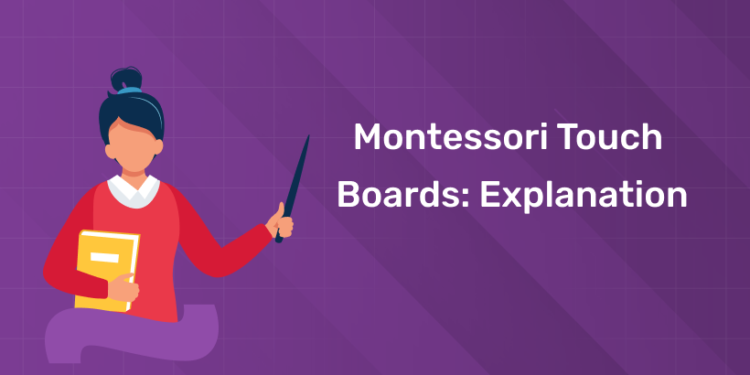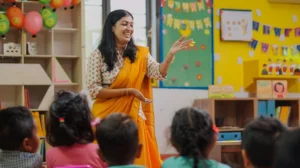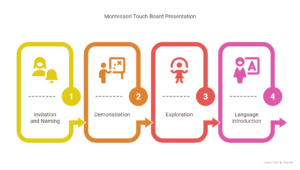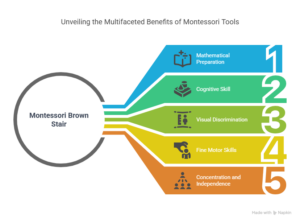Table of Contents
Imagine a child running their fingertips across a smooth wooden board, their eyes lighting up as they discover texture through touch. In Montessori classrooms, the Touch Boards are a cornerstone of sensory education, sparking curiosity and development. This blog dives deep into what Touch Boards are, their purpose, benefits, and role in shaping young minds. Whether you’re a parent, teacher, or Montessori enthusiast, let’s explore how Touch Boards foster growth!
Unlock your passion for education as a Montessori teacher!
Introduction
Montessori education is all about sensory learning, which means children learn through direct experience of their environment using all their senses. Touch being one of the primary senses plays a big role in the early stages of a child’s learning journey.
The Montessori Touch Boards are a set of tactile learning materials to refine a child’s sense of touch by offering different textures to explore. These boards allow children to experience rough and smooth surfaces. This helps them develop skills that will aid in language acquisition and writing readiness.
Similarly the Montessori Brown Stair, a tool to enhance a child’s visual and tactile sense of dimensions introduces mathematical concepts in a subtle way. These materials though targeting different senses both refine the child’s cognitive and motor skills.
See an example of the Montessori Brown Stair in the classroom here.
What is a Montessori Touch Board?
1: What is the primary focus of the first plane of development in the Montessori method?
The Montessori Touch Board is a sensory material that comes in three types of boards:
- Touch Board 1: Divided into two sections, one side is rough and the other is smooth. This allows the child to experience a big contrast in textures.
- Touch Board 2: Divided into strips of different degrees of roughness, this board helps the child to differentiate finer textures.
- Touch Board 3: A variation that has a range of textures from very rough to very smooth to allow more precise differentiation.
The purpose of the Touch Boards is to refine the child’s sense of touch and introduce the concept of texture which will later prepare them for writing and other fine motor activities. This material is introduced to children between 2.5 to 3.5 years and is part of the Sensorial curriculum in Montessori education.
Using these boards helps children become more aware of the textures they encounter in their daily life. By experiencing materials of different roughness and smoothness children build a strong tactile memory which is essential for sensory development.
Get Certified & Start Your Montessori Career
Montessori Teacher Training Course by Entri App: Gain expert skills, earn certification, and kickstart your teaching career.
Join Now!Presentation of the Touch Boards
Touch Boards are presented to the child in a specific Montessori way so that children can then explore the materials independently after being shown how to use them.
Step 1: Invitation and Naming
The teacher invites the child to a special space, usually on a mat or table, and names the touch boards. The teacher tells the child what each board is called and how it is used.
Step 2: Demonstration
The teacher demonstrates how to use the boards. For the first touch board the teacher gently runs their fingers over the rough side and then the smooth side and pauses to point out the difference in texture. The child is to watch closely and do the same.
Step 3: Exploration
Once the child has learned how to use the board they are to explore it independently. The child can move their fingers across the surfaces, compare textures and see how the rough and smooth feel different. This is key to the Montessori method.
Step 4: Language
As the child is working with the touch boards the teacher introduces vocabulary to describe the textures using words like “rough”, “smooth”, “softer” and “harder”. This adds a language element to the activity and helps the child connect the tactile sensations with the words.
By this structured but flexible presentation children develop their sense of touch and language, preparing them for tasks that require tactile awareness like writing.
What are the benefits of Montessori Touch Boards?
Montessori Touch Boards are all about refining the sense of touch but the Montessori Brown Stair is for something different, to develop visual and spatial awareness. The Brown Stair is for children to understand size and dimension by stacking and arranging blocks from biggest to smallest.
Here’s how the Montessori Brown Stair fits into the learning journey that starts with the touch boards:
- Mathematical Preparation: While the touch boards are developing tactile discrimination, the Brown Stair is introducing children to early mathematical concepts. These concepts include sequencing, dimension, and volume.
- Cognitive Skill: Children are beginning to understand thickness which lays the foundation for understanding geometry and maths later on.
- Visual Discrimination: The Brown Stair allows children to see size differences, they can notice the subtle differences in block thickness. This complements the tactile discrimination learned with the Touch Boards.
- Fine Motor Skills: Both materials require careful handling so children are improving their fine motor control. The precise placement of the Brown Stair blocks and the gentle movement of fingers across the Touch Boards are developing dexterity. They are also developing hand-eye coordination.
- Concentration and Independence: Just as with the Touch Boards children are working independently with the Brown Stair so they are improving their concentration and focus. The self correcting nature of the materials is encouraging children to take control of their own learning.
These benefits illustrate how the Brown Stair and Touch Boards are not isolated materials. They are part of a cohesive Montessori system that nurtures a child’s overall development.
Unlock your passion for education as a Montessori teacher!
Extensions of Montessori Materials
Montessori teachers often use extensions to go deeper with the materials. Extensions for the Touch Boards include pairing them with other sensory materials. These materials include the Rough and Smooth Boards or the Fabric Box. This introduces more complex tactile differences.
For the Montessori Brown Stair, extensions are to combine it with the Pink Tower, another Montessori material that focuses on size and shape differences, to challenge the child more on spatial relationships.
And teachers can combine both the Touch Boards and the Brown Stair into thematic learning like textures in nature or building shapes with materials of different thickness.
Get Certified & Start Your Montessori Career
Montessori Teacher Training Course by Entri App: Gain expert skills, earn certification, and kickstart your teaching career.
Join Now!Conclusion
In 2025, Montessori Touch Boards are more than wooden tools—they’re gateways to sensory development, fine motor skills, and academic readiness. As Kerala’s Montessori schools thrive with 60% enrollment growth and 25% job increases, these boards empower children to explore, focus, and grow. Parents and educators can unlock their potential through guided activities, while Entri’s Montessori Teacher Training Course equips teachers with NSDC certification and practical expertise to lead child-centric classrooms. Ready to inspire young learners? Join Entri’s free demo and discover how Touch Boards shape bright futures in Kerala and beyond!
Get Certified & Start Your Montessori Career
Montessori Teacher Training Course by Entri App: Gain expert skills, earn certification, and kickstart your teaching career.
Join Now!Frequently Asked Questions
What are Montessori Touch Boards?
Montessori Touch Boards are sensorial materials that help children refine their sense of touch by offering different textures to explore.
What is the purpose of the Montessori Touch Boards?
The purpose is to develop tactile discrimination and sensory awareness, preparing children for tasks requiring fine motor skills, such as writing.
How do Touch Boards benefit a child's learning?
Touch Boards enhance a child’s sense of touch, introduce texture-related vocabulary, and build fine motor control.
How is the Montessori Brown Stair used?
The Montessori Brown Stair is a visual material that helps children understand size and dimension, preparing them for geometric and mathematical learning.
At what age are Montessori Touch Boards introduced?
They are typically introduced between the ages of 2.5 to 3.5 years.
Can Montessori Touch Boards be used with other materials?
Yes, they are often used alongside other sensorial materials like the Rough and Smooth Boards for further tactile exploration.
How do Montessori Touch Boards help with language development?
Teachers introduce descriptive vocabulary such as “rough” and “smooth” while children work with the boards, enhancing their language skills.
What are extension activities for the Montessori Brown Stair?
Extension activities may include combining the Brown Stair with the Pink Tower to deepen the child’s understanding of size and proportion.
How does Entri’s Montessori course help educators?
Entri’s Montessori Teachers Training Course equips educators with the skills to effectively use Montessori materials and guide children through sensory-based learning.















